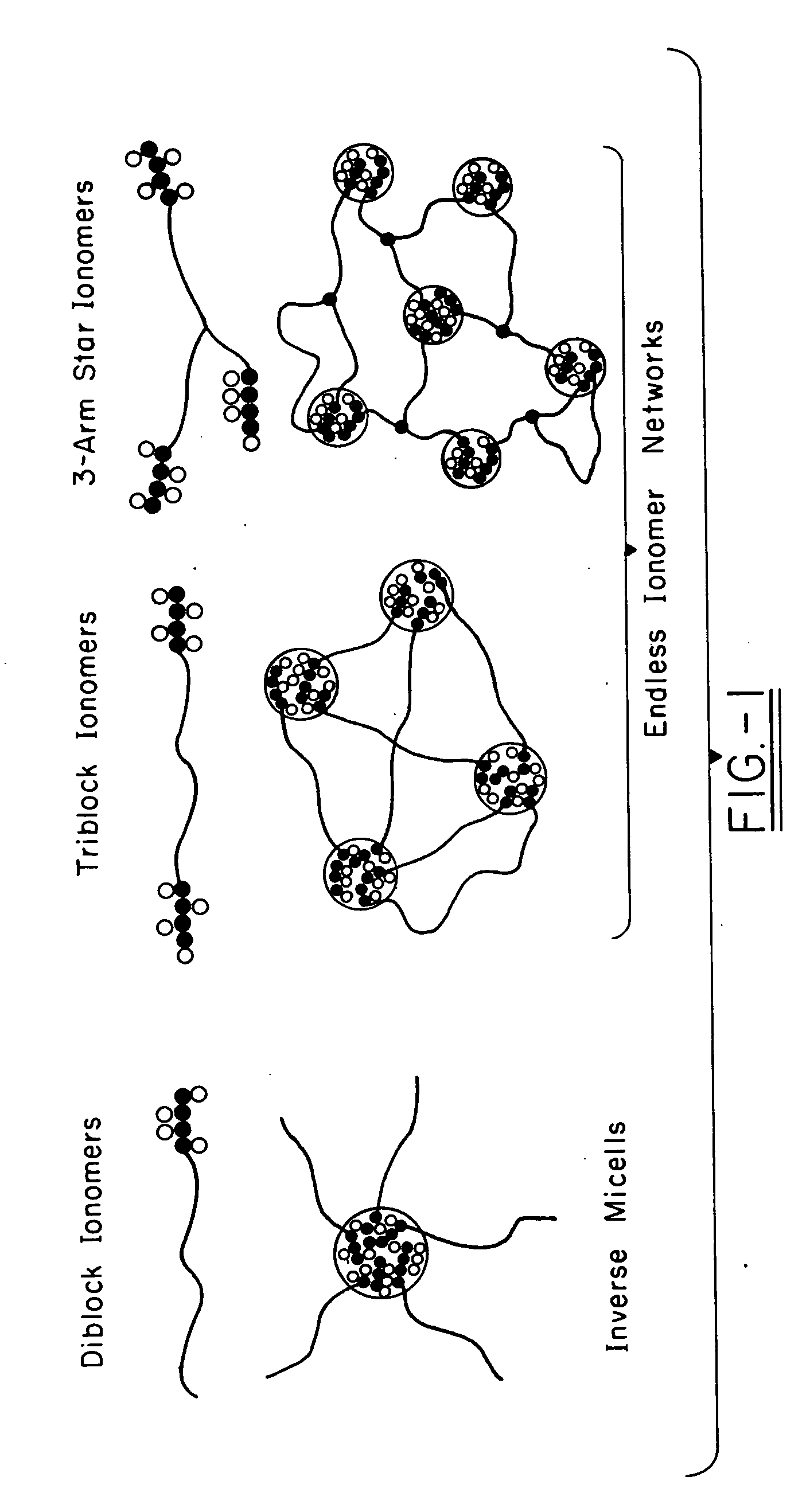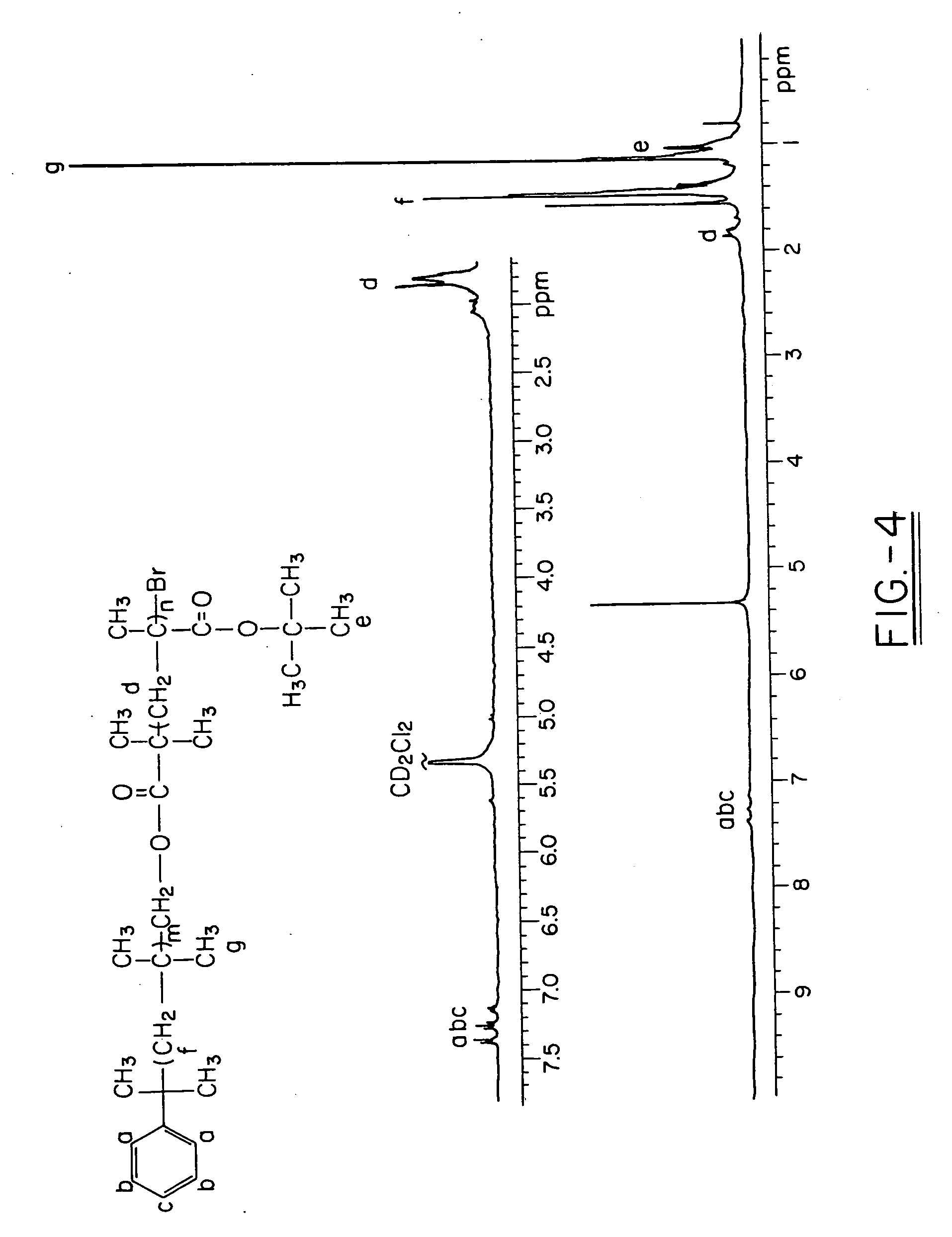Polyisobutylene-based block anionomers and cationomers and synthesis thereof
a technology of polyisobutylene and cationomers, applied in the field of block ionomers, can solve the problem that the patent does not disclose the ionization of a methacrylate or amin
- Summary
- Abstract
- Description
- Claims
- Application Information
AI Technical Summary
Benefits of technology
Problems solved by technology
Method used
Image
Examples
example i
[0097] Materials. tert-Butyl methacrylate (tBMA) (Aldrich, 98%) was washed three times with 1.0N NaOH, extracted three times with distilled H2O, dried over anhydrous MgSO4, filtered, and vacuum distilled. Copper (I) bromide (Aldrich, 98%) and copper (I) chloride (Aldrich, 98%) were purified according to Keller et al. Tetrahydrofuran (THF) and CH2Cl2 were dried by refluxing over calcium hydride and distilled before use. Isobutylene (IB) and methyl chloride (MeCl) (Linde Division, Union Carbide Corp.) Gases were passed through a drying column packed with barium oxide and molecular sieves. n-Hexane (Aldrich) was refluxed over concentrated sulfuric acid for two days, the organic layer was washed with distilled water, dried with MgSO4, stored over CaH2, and distilled under dry N2 before use. Triethylamine (Aldrich, 99%) and DMAEMA (98%, Aldrich) were freshly distilled before use. N,N,N′,N′,N″-pentamethyldiethylenetriamine (PMDETA) (Aldrich, 99%), 2-bromoisobutyryl bromide (BiBB) (Aldrich...
example 2
[0123] The materials, equipment and methods for the preparation of the PIB and macroinitiator (PIB-iBB) are identical to those in Example 1.
[0124] Preparatory to the synthesis of the target di- and triblocks, model ATRPs of DMAEMA have been conducted. We have examined in some detail the polymerization of DMAEMA mediated by the EBiB / CuBr / PMDETA system:
[0125] Table 5 shows the effect of experimental conditions on our (model) homopolymerization of DMAEMA. The solvent plays an important role in the ATRP of PDMAEMA. Polar solvents, such as dichlorobenzene and anisole, provide good media and lead to satisfactory product. Increasing the temperature or the amount of the ligand gave increased conversions. By the use of 3 mol / L monomer and anisole as solvent, we have obtained over 60% conversion in 20 mins with PDI˜1.3. The use of benzene, toluene and THF gave slow and poorly controlled polymerizations, and broad PDIs. Increasing the amount of the PMDETA ligand led to somewhat lower PDI (1...
PUM
| Property | Measurement | Unit |
|---|---|---|
| mol % | aaaaa | aaaaa |
| mol % | aaaaa | aaaaa |
| molecular weight distribution | aaaaa | aaaaa |
Abstract
Description
Claims
Application Information
 Login to View More
Login to View More - R&D
- Intellectual Property
- Life Sciences
- Materials
- Tech Scout
- Unparalleled Data Quality
- Higher Quality Content
- 60% Fewer Hallucinations
Browse by: Latest US Patents, China's latest patents, Technical Efficacy Thesaurus, Application Domain, Technology Topic, Popular Technical Reports.
© 2025 PatSnap. All rights reserved.Legal|Privacy policy|Modern Slavery Act Transparency Statement|Sitemap|About US| Contact US: help@patsnap.com



